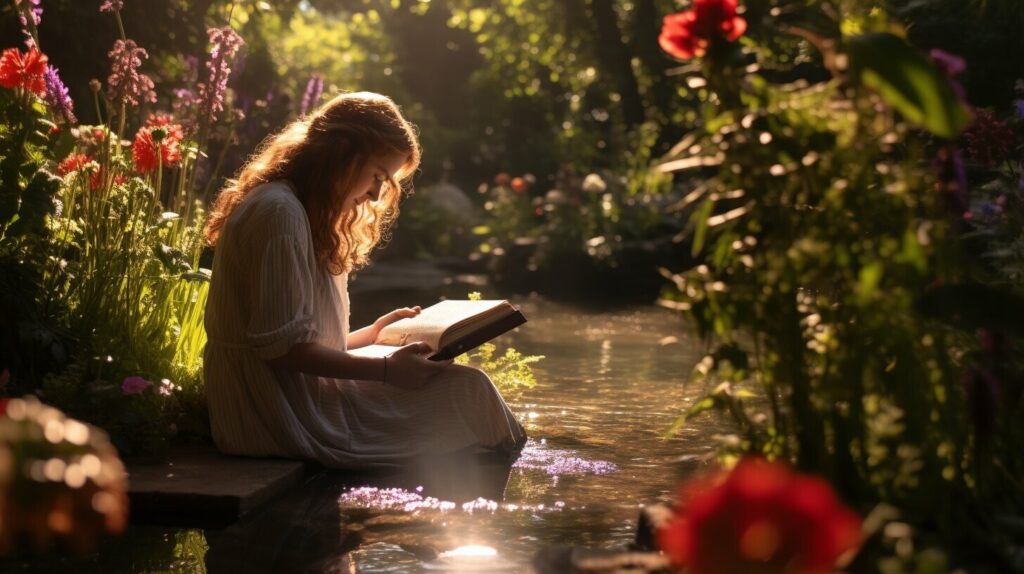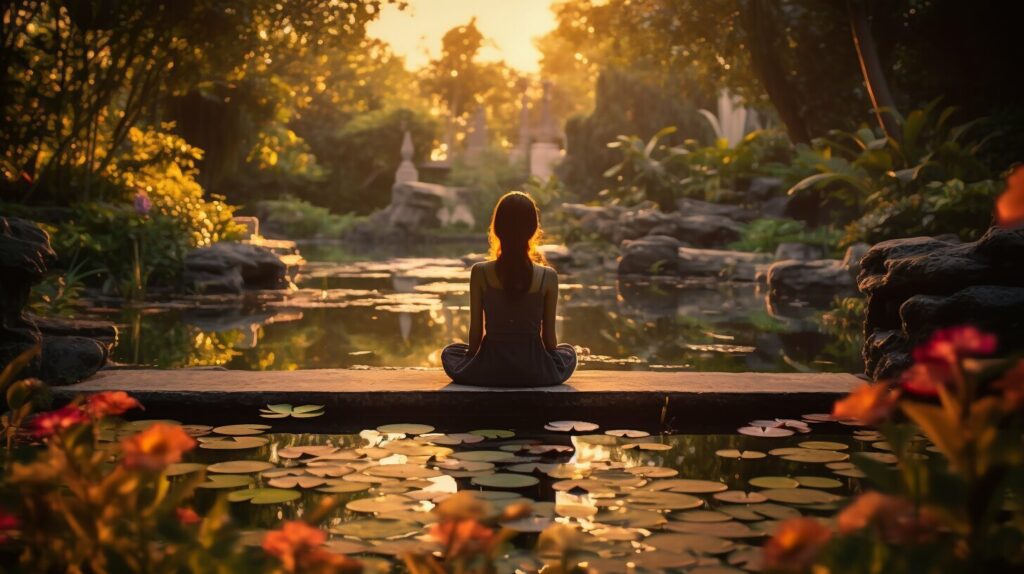In today’s fast-paced world, finding inner peace can feel like a distant dream. The constant barrage of responsibilities, stress, and distractions can leave you feeling overwhelmed and disconnected from yourself. But there is hope. By exploring spiritual healing techniques, you can tap into a wellspring of peace and tranquility that resides within you.
From energy healing to meditation, gratitude, self-care, and more, there are numerous approaches you can incorporate into your life to cultivate inner peace. By taking the time to prioritize your well-being and explore these techniques, you can embark on a transformative journey towards greater harmony and self-discovery.
Key Takeaways:
- Inner peace is a skill that can be developed through self-awareness, self-acceptance, and self-love.
- Spiritual healing techniques, such as energy healing and meditation, can help you find inner peace.
- Gratitude, self-care, and embracing authenticity are essential for maintaining lasting inner peace.
- Letting go of control and serving others can bring joy and contribute to your sense of inner peace.
- Spending time in nature and grounding exercises can help you reconnect with yourself and experience a deep sense of peace.
Energy Healing for Inner Peace
When it comes to finding inner peace, energy healing techniques can be incredibly powerful. Two popular methods for addressing emotional energy and finding balance are the Emotion Code and the Body Code. These techniques help identify and release trapped emotions, allowing you to experience a greater sense of peace and well-being.
The Emotion Code, developed by Dr. Bradley Nelson, focuses on identifying and releasing trapped emotions that can cause imbalances in the body. Trapped emotions are negative energy vibrations that become lodged in various organs or tissues, disrupting your energy flow and contributing to emotional distress. By utilizing the Emotion Code, practitioners can help release these trapped emotions, allowing you to experience inner peace and emotional freedom.
The Body Code, also developed by Dr. Bradley Nelson, takes a more comprehensive approach to energy healing. It addresses imbalances in six key areas: energies, circuitry, toxicity, pathogens, structural, and nutrition. By addressing these areas, practitioners of the Body Code can help bring your mind and body back into balance, allowing for a deeper sense of inner peace and overall well-being.
If you’re considering energy healing for finding inner peace, it’s important to work with a certified practitioner who can guide you through the process. They will have the knowledge and experience to accurately identify and release trapped emotions or address any imbalances in your energy system. With their support, you can embark on a transformative journey towards inner peace and emotional well-being.
Powerful Techniques of Energy Healing for Inner Peace
- Emotion Code
- Body Code
Testimonials
“Energy healing has completely transformed my life. I spent years feeling stuck and overwhelmed by my emotions, but after working with a practitioner trained in the Emotion Code, I finally found the inner peace I had been searching for. I highly recommend energy healing to anyone seeking a greater sense of well-being and emotional freedom.” – Sarah L.
“I had been struggling with chronic pain and fatigue, and nothing seemed to help. It wasn’t until I discovered the Body Code that I found real relief. By addressing the imbalances in my energy system, I experienced a profound shift in my overall health and well-being. I am forever grateful for the power of energy healing.” – Michael R.
Energy healing, such as the Emotion Code and the Body Code, offers a transformative approach to finding inner peace. By releasing trapped emotions and addressing imbalances in your energy system, you can experience a deeper sense of well-being and emotional freedom. Take the first step on your journey to inner peace by exploring the powerful techniques of energy healing.

Meditation for Inner Peace
Meditation is a powerful practice that can help you find inner peace and cultivate a sense of tranquility amidst the chaos of daily life. By creating a space for stillness and reflection, meditation allows you to calm your mind, reduce stress, and enhance your overall well-being. Through the practice of mindfulness and focusing on your breath and relaxation, you can experience a deep sense of peace and clarity.

When you engage in meditation, you are giving yourself the opportunity to fully immerse in the present moment. By letting go of the past and not worrying about the future, you can release anxiety and gain a renewed sense of peace and calm. As you practice meditation consistently, you will notice that your ability to remain mindful and present extends beyond your meditation sessions and into your everyday life. This heightened sense of awareness and peace of mind can greatly contribute to your overall sense of inner peace.
“Meditation is not a means to an end. It is both the means and the end.” – Jiddu Krishnamurti
Incorporating meditation into your daily routine does not have to be complicated or time-consuming. Even just a few minutes of meditation each day can make a significant difference in your overall well-being. You can choose to practice guided meditation using mobile apps or online resources, or you can simply find a quiet space, close your eyes, and focus on your breath. The key is to set aside dedicated time for yourself and make meditation a regular part of your self-care routine.
Mindfulness Meditation Techniques:
- Body scan meditation: Focus your attention on different parts of your body, starting from your toes and gradually moving up to the top of your head. Notice any sensations or feelings that arise without judgment.
- Loving-kindness meditation: Cultivate feelings of love, compassion, and kindness towards yourself and others. Repeat loving-kindness phrases like “May I be happy, may I be healthy, may I live with ease” or customize them to suit your needs.
- Breathing meditation: Pay attention to your breath as it naturally flows in and out of your body. Notice the sensation of each breath and gently bring your focus back whenever your mind starts to wander.
By incorporating meditation into your daily life, you can tap into your inner peace and discover a sense of mindfulness, clarity, and peace of mind that will positively impact all aspects of your life.
Cultivating Gratitude
Gratitude is a powerful emotion that can bring about a deep sense of inner peace and contentment. When you take the time to acknowledge and appreciate the things you have, whether big or small, you shift your mindset from a place of lack to one of abundance. Cultivating gratitude is a practice that can enhance your overall well-being and help you find inner peace.
One way to cultivate gratitude is to keep a gratitude journal. Each day, take a few moments to write down three things you are grateful for. These can be simple things like a beautiful sunrise, a loving pet, or a kind gesture from a friend. By focusing on the positive aspects of your life, you train your mind to seek out and appreciate the good, which in turn promotes feelings of contentment and peace.
Another way to practice gratitude is by expressing it to others. Take the time to thank someone for their help, support, or kindness. A simple thank you can go a long way in showing appreciation and fostering a sense of connection. Not only does expressing gratitude benefit the recipient, but it also deepens your own sense of gratitude and inner peace.
“Gratitude unlocks the fullness of life. It turns what we have into enough, and more. It turns denial into acceptance, chaos to order, confusion to clarity. It can turn a meal into a feast, a house into a home, a stranger into a friend.” – Melody Beattie
Practicing mindfulness is another powerful way to cultivate gratitude. By being fully present in each moment and paying attention to the sights, sounds, and sensations around you, you can develop a deeper appreciation for life’s simple pleasures. Mindfulness allows you to savor the present moment and find contentment in the here and now, leading to a greater sense of inner peace.
Incorporating gratitude into your daily life can have a profound impact on your overall well-being. By adopting a mindset of gratitude, expressing appreciation to others, and embracing mindfulness, you can cultivate a deep sense of contentment and find inner peace.
The Power of Gratitude Table
| Benefits of Gratitude | Ways to Cultivate Gratitude |
|---|---|
| 1. Increased happiness | 1. Keep a gratitude journal |
| 2. Improved relationships | 2. Express gratitude to others |
| 3. Reduced stress and anxiety | 3. Practice mindfulness |
| 4. Enhanced overall well-being | 4. Reflect on the positive aspects of your life |

The Importance of Self-Care
When it comes to finding inner peace, one of the most crucial practices is self-care. Taking the time to prioritize your own needs is essential for maintaining a sense of well-being and reducing stress. By engaging in self-care activities, you are not only nurturing yourself but also creating a solid foundation for inner peace to flourish. So, let’s explore why self-care is so important and how it can contribute to your overall sense of tranquility.
Self-care encompasses a wide range of activities and practices that promote physical, mental, and emotional well-being. It involves listening to your body’s needs and taking proactive steps to meet them. Whether it’s going for a walk in nature, indulging in a relaxing bath, or practicing mindfulness meditation, self-care allows you to reconnect with yourself and recharge your energy.
Table: Benefits of Self-Care
| Physical Benefits | Mental Benefits | Emotional Benefits |
|---|---|---|
| Reduces stress | Enhances clarity of mind | Boosts self-esteem |
| Improves sleep quality | Increases focus and concentration | Decreases anxiety and depression |
| Boosts immune system | Reduces symptoms of burnout | Promotes emotional well-being |
Quote: “Self-care is not a luxury, it’s a necessity. It’s about giving yourself permission to pause, to take care of yourself without guilt, and to prioritize your well-being.” – Unknown
Creating a self-care routine is a personal journey that requires ongoing exploration and experimentation. Start by identifying activities that bring you joy and make you feel good. It could be as simple as curling up with a good book, cooking a nutritious meal, or spending quality time with loved ones. Whatever self-care looks like for you, remember that it’s not selfish but rather an act of self-love and preservation.
The Role of Self-Care in Finding Inner Peace
Self-care plays a crucial role in finding inner peace by providing the necessary tools to manage stress and cultivate a positive mindset. When you prioritize your own well-being and make self-care a non-negotiable part of your daily routine, you are better equipped to handle life’s challenges with grace and resilience.
By investing time and effort into self-care practices, you are sending a powerful message to yourself that your needs matter and deserve attention. This act of self-nurturing creates a solid foundation for inner peace to grow and flourish. So, take a moment to reflect on your self-care routine and consider how you can make it a priority in your life. Your journey towards inner peace starts with taking care of yourself.

Finding Inspiration Daily
When it comes to maintaining inner peace, finding daily inspiration can make a significant difference. Inspiration has the power to uplift your spirits, bring you closer to inner peace, and cultivate a positive mindset. There are various ways you can seek out inspiration in your daily life.
Reading Daily Quotes
One simple yet effective way to find inspiration is by reading daily quotes. These powerful words of wisdom can provide you with a fresh perspective, motivate you to overcome challenges, and remind you of the beauty and possibilities that exist in life. You can find daily quote publications, follow social media accounts dedicated to sharing inspirational quotes, or even create a personal quote journal where you collect quotes that resonate with you.
Watching TED Talks
TED Talks are another great source of inspiration. These informative and thought-provoking speeches cover a wide range of topics and feature experts from various fields. Whether it’s learning about personal development, creativity, or mindfulness, TED Talks can ignite your curiosity, broaden your horizons, and leave you feeling inspired and motivated. With a vast library of talks available online, you can always find something that resonates with you.
Connecting with Others
One often overlooked source of inspiration is connecting with others. Engaging in meaningful conversations, sharing ideas, and listening to different perspectives can stimulate your mind and provide new insights. Surrounding yourself with positive and like-minded individuals can also foster an environment of support and encouragement, allowing you to draw inspiration from their experiences and achievements.

By actively seeking out daily inspiration, you can infuse your life with positivity, motivation, and a deeper sense of inner peace. Whether it’s through reading quotes, watching TED Talks, or connecting with others, remember to make inspiration a part of your daily routine.
Living in the Present Moment
In today’s fast-paced world, it’s easy to get caught up in the worries of the past and the uncertainties of the future. However, finding inner peace often requires us to let go of these concerns and fully embrace the present moment. Mindfulness, the practice of being fully present and aware of our thoughts, feelings, and surroundings, is a powerful tool for achieving this state of centeredness and tranquility.
Mindfulness allows us to appreciate the beauty and richness of each passing moment. By intentionally directing our attention to the present, we can let go of regrets about the past and anxieties about the future. When we are fully present, we can experience a deep sense of inner peace, free from the burdens of the past and the worries of the future.
One way to cultivate mindfulness and live in the present moment is through meditation. Taking just a few minutes each day to sit quietly and focus on our breath can help quiet the mind and bring us into the present moment. Not only does meditation reduce stress and increase relaxation, but it also enhances our overall sense of inner peace.

Another way to embrace the present moment is by engaging in activities that bring us joy and fully capture our attention. Whether it’s playing an instrument, painting, or spending time in nature, these moments of flow allow us to immerse ourselves in the present and experience a deep sense of peace.
Ultimately, living in the present moment is a practice that requires conscious effort and awareness. By incorporating mindfulness into our daily lives, we can cultivate a greater sense of inner peace and enjoy the richness and beauty of each passing moment.
Authenticity and Inner Peace
Finding inner peace begins with embracing your authentic self. Living a life true to your values and desires allows you to cultivate a deep sense of inner peace and fulfillment. When you are authentic, you are no longer living to please others or seeking external validation. Instead, you are guided by your own inner compass, making choices that align with your true essence.
Accepting and celebrating your unique qualities and quirks is an essential part of self-acceptance. Embracing your authentic self means embracing both your strengths and weaknesses, recognizing that they are all part of what makes you who you are. Remember that nobody is perfect, and it is through accepting our imperfections that we find true peace within.
Authenticity also means being honest and transparent in your relationships and interactions with others. When you show up as your genuine self, you attract people who appreciate and accept you for who you are. This creates a supportive and nurturing environment that further enhances your sense of inner peace.
Embrace Your True Self
Embracing your authenticity starts with self-reflection. Take the time to discover what truly matters to you, what brings you joy, and what aligns with your values. Consider journaling or talking with a trusted friend or therapist to gain clarity on your authentic self. Once you have a better understanding of who you are, make a commitment to honor and express that true self in your daily life.
Embracing your authenticity means embracing both your strengths and weaknesses, recognizing that they are all part of what makes you who you are.
Release any expectations or pressures you may have placed on yourself to conform to the expectations of others. Remember that you are unique, and your journey is yours alone. Embrace your passions, follow your dreams, and live a life that feels authentic to you.
Table: The Benefits of Authenticity
| Benefits | Explanation |
|---|---|
| Increased self-confidence | Embracing your authentic self boosts self-confidence as you no longer feel the need to pretend or hide who you truly are. |
| Stronger relationships | Being authentic allows for deeper connections with others, as they can see and appreciate your genuine self. |
| Greater sense of fulfillment | Living authentically means honoring your true passions and desires, leading to a more fulfilling life. |
| Reduced stress and anxiety | Letting go of the need to conform to others’ expectations eases stress and anxiety, creating space for inner peace. |
| Improved overall well-being | Embracing your authentic self positively impacts your emotional, mental, and physical well-being. |
Remember that authenticity is an ongoing journey. It may take time and practice to fully embrace your true self and find inner peace. Be patient and kind to yourself as you navigate this process. Embracing your authenticity is a powerful step toward living a life filled with joy, fulfillment, and inner peace.

Sources: Psychology Today, Positive Psychology
Letting Go of Control
One of the key factors that can hinder our ability to find inner peace is the need for control. Trying to control everything in life can lead to increased stress, anxiety, and a constant state of tension. However, letting go of what you can’t control is essential for finding true inner peace. It allows you to embrace the natural flow of life and find comfort in surrendering to the unknown.
Letting go is not about giving up or being passive; it is about releasing the need to control outcomes and accepting that there are things that are beyond our control. By focusing on what you can change and letting go of the rest, you free yourself from unnecessary burdens and find a greater sense of peace and acceptance.
“The only way to make sense out of change is to plunge into it, move with it, and join the dance.” – Alan Watts
Benefits of letting go:
- Reduced stress and anxiety
- Increased sense of freedom and liberation
- Improved relationships and interactions with others
- Enhanced ability to adapt to change
- Heightened sense of self-awareness and self-acceptance
Letting go is not always easy, but it is a practice that can be cultivated. By consciously acknowledging the things that are beyond your control and shifting your focus to what you can change, you can start to experience a greater sense of inner peace. Surrendering to the flow of life and embracing uncertainty can open doors to new possibilities and allow you to live with a more peaceful and easeful mindset.
| Things to Let Go of: | Benefits of Letting Go: |
|---|---|
| Fear of the unknown | Embracing new opportunities and experiences |
| Need for approval | Greater self-acceptance and authentic living |
| Past regrets and resentments | Emotional freedom and forgiveness |
| Excessive attachment to outcomes | Reduced stress and increased satisfaction with the present |
| Desire for control | Increased sense of peace and acceptance |
Remember, letting go is a process and takes time. It is a journey that requires practice and self-reflection. As you continue to let go of control and surrender to the present moment, you will find that true inner peace begins to emerge.

Serving Others and Finding Joy
Serving others is not only a selfless act of kindness but also a pathway to finding inner peace. When you extend a helping hand to those in need, you create a ripple effect of positivity that brings joy not just to others, but also to yourself. Acts of kindness can be as simple as offering a listening ear, volunteering your time, or performing random acts of kindness to brighten someone’s day.
Research has shown that serving others activates the brain’s reward center and releases feel-good hormones like oxytocin, serotonin, and dopamine. These hormones are associated with feelings of happiness, contentment, and overall well-being. By engaging in acts of kindness, you not only improve the lives of others but also boost your own sense of fulfillment and inner peace.
“No act of kindness, no matter how small, is ever wasted.” – Aesop
When you serve others, you shift your focus away from your own worries and challenges. This shift in perspective allows you to gain a greater appreciation for the blessings in your life and develop a sense of gratitude. Gratitude, in turn, fosters inner peace by helping you cultivate contentment and a positive outlook.
The Power of Serving Others:
| Benefits of Serving Others | Examples |
|---|---|
| Increased sense of purpose and meaning | Volunteering at a local shelter |
| Enhanced social connections and relationships | Helping a friend in need |
| Reduced stress and improved mental health | Supporting a family member during a difficult time |
| Greater self-awareness and personal growth | Mentoring a young person |
| Increased empathy and compassion | Participating in community service projects |
By serving others and spreading kindness, you not only contribute to the well-being of individuals and communities but also nurture your own inner peace and happiness. Remember, even the smallest acts of kindness can make a world of difference, so let compassion be your guiding light.
The Power of Nature for Grounding and Inner Peace
Are you seeking a sense of inner peace and tranquility? Look no further than the healing power of nature. Spending time in nature can have a profound impact on your well-being, helping you to feel grounded and centered.
When you immerse yourself in the beauty and serenity of natural surroundings, it allows you to disconnect from the chaos of daily life and find solace in the present moment. Whether you choose to take a refreshing hike in the mountains, walk barefoot on the grass, or simply sit by the ocean, nature has a way of restoring your inner peace.
One of the key benefits of spending time in nature is grounding. Grounding, also known as earthing, involves physically connecting with the earth’s energy. By walking barefoot on the earth or even lying down on the grass, you can absorb the earth’s electrons, which have been found to have a positive impact on your overall well-being.
So next time you’re feeling overwhelmed or disconnected, take a moment to step outside and connect with the natural world around you. Embrace the beauty of nature, feel the earth beneath your feet, and let the healing power of nature restore your inner peace.
FAQ
How can I develop inner peace?
Inner peace can be developed through practices such as self-awareness, self-acceptance, and self-love. Techniques like energy healing, meditation, gratitude, and self-care can also be effective in cultivating inner peace.
What is energy healing?
Energy healing is a practice that involves addressing emotional energy that may become trapped in the body. Techniques like the Emotion Code and the Body Code can help identify and release trapped emotions, leading to inner peace and the release of negative energy.
How does meditation help with inner peace?
Meditation is a powerful practice for finding inner peace. By spending a few minutes each day in meditation, you can calm your mind, reduce stress, and cultivate a sense of peace and relaxation. Focus on your breath and being present in the moment.
How does gratitude contribute to inner peace?
Gratitude is a high vibration emotion that can enhance your sense of inner peace. By taking a few minutes each day to focus on gratitude, you can shift your mindset to abundance and cultivate contentment and a greater sense of peace.
Why is self-care important for inner peace?
Self-care is crucial for maintaining inner peace. By prioritizing your own needs and engaging in activities like walking, buying something for yourself, or practicing good nutrition, you can significantly impact your sense of well-being and handle stress better.
How can I find daily inspiration for inner peace?
Seeking out daily inspiration, such as reading a quote or watching a TED Talk, can help lift your spirits and bring you closer to inner peace. Connect with a friend or engage in activities that inspire you to maintain a positive mindset.
How do I live in the present moment for inner peace?
Being present in the moment is essential for finding inner peace. Let go of the past and future, focusing on what is happening right now. Be mindful of the time and space around you to increase your sense of inner peace and reduce anxiety.
How does authenticity contribute to inner peace?
Living a life true to yourself is crucial for maintaining inner peace. Embrace your authentic self, let go of the need for approval, and align your life with your true values and desires to cultivate inner peace and live a life of joy and fulfillment.
Why is letting go of control important for finding inner peace?
Trying to control everything in life can lead to stress and anxiety. Letting go of what you can’t control is essential for finding inner peace. Focus on what you can change and accept that there are things beyond your control for a greater sense of peace and acceptance.
How does serving others contribute to inner peace?
Serving others brings a deep sense of joy and inner peace. By helping those in need, you take your mind off your own troubles and contribute to the well-being of others. Acts of kindness benefit both the receiver and yourself, contributing to your own inner peace.
How does spending time in nature help with inner peace?
Spending time in nature allows you to disconnect from the chaos of daily life and appreciate the beauty and majesty of the world. Grounding exercises like walking barefoot or spending time at the beach can help you reconnect with the earth and experience a sense of peace and harmony.
